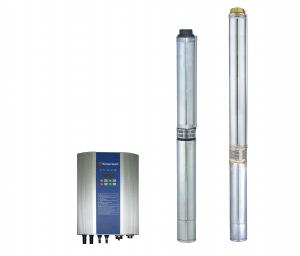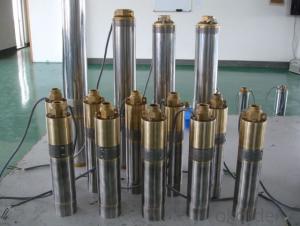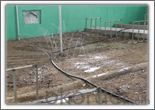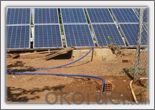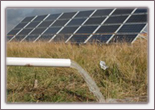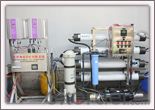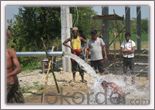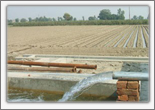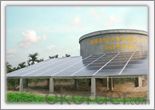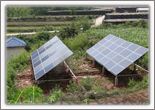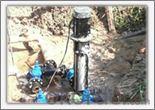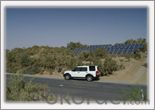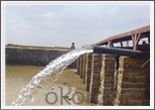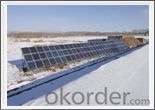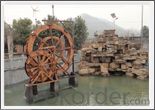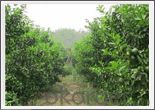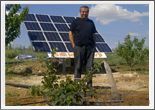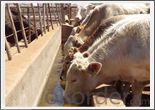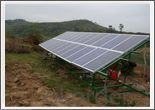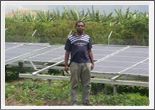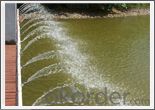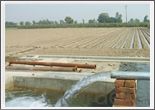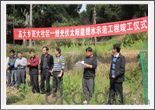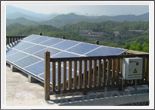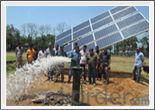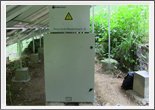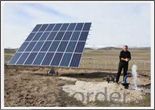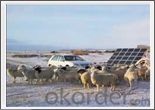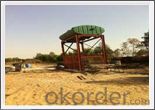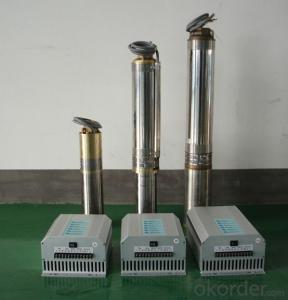Solar Pumping Systems Water for Life Solar Pump
- Loading Port:
- Shekou
- Payment Terms:
- TT OR LC
- Min Order Qty:
- 20 unit
- Supply Capability:
- 800000 unit/month
OKorder Service Pledge
OKorder Financial Service
You Might Also Like
Solar Inverter Introduction:
Solar pumping inverter converts DC current from the solar array into AC current to drive the pump. With the function of MPPT (maximum power point tracking), it regulates the output frequency according to irradiation in real time to achieve the maximum power.
Solar Inverters Features:
1. Adopting the proposed dynamic VI maximum power point tracking (MPPT) control method; Fast response and stable operation; Better than the conventional methods which may lead to the problems including poor tracking performances, unstable or even cause water hammer damaging when the irradiation on the array changes rapidly.
2. The solar pumping inverters system is dispensed with energy storing devices, and stores water instead of electricity. It improves the reliability of the device, at the same time, it lowers the construction and maintenance costs of the system dramatically.
3. Digital control; automatic operation and data acquisition/storage of 8 years, etc; 98% of conversion efficiency, and complete protection.
4. In-line blocks; user friendly; convenient for operating; perfect cooling and shielding.
Solar Pumping Inverter Advantages:
1. To drive pumps equipped with 3-phase induction motors.
2. Optimized SPWM.
3. Various operation modes and MPPT algorithms are available.
4. Adjustable speed range of pump based on the actual situation of the system.
5. Available option of water-level detecting and control circuit.
6. Protection functions: lightning, over/low input voltage, over current and over load protection, etc.
7. Enclosure class: IP52.
8. Ambient temperature:-10~+50˚C.
Specification:
Model | Maximum input dc voltage | Recommended MPP Voltage | Rated Output Current | Output Voltage | Output Frequency | Net Weight | Gross Weight | Package Size | ||
Length | Width | Height | ||||||||
PB5500H | 750 | 500-600 | 13 | 3PH 380V | 0-50 | 7.3 | 9.6 | 425 | 325 | 285 |
PB7500H | 750 | 500-600 | 18 | 3PH 380V | 0-50 | 7.7 | 10 | 425 | 325 | 285 |
PB11KH | 750 | 500-600 | 24 | 3PH 380V | 0-50 | 8.2 | 10.5 | 425 | 325 | 285 |
PB15KH | 750 | 500-600 | 30 | 3PH 380V | 0-50 | 8.4 | 10.7 | 425 | 325 | 285 |
PB18KH | 750 | 500-600 | 39 | 3PH 380V | 0-50 | 8.4 | 10.7 | 425 | 325 | 285 |
PB22KH | 750 | 500-600 | 45 | 3PH 380V | 0-50 | 18 | 21 | 600 | 465 | 350 |
PB30KH | 750 | 500-600 | 60 | 3PH 380V | 0-50 | 18 | 21 | 600 | 465 | 350 |
PB37KH | 750 | 500-600 | 75 | 3PH 380V | 0-50 | 20 | 23 | 600 | 465 | 350 |
PB45KH | 750 | 500-600 | 91 | 3PH 380V | 0-50 | 20 | 23 | 600 | 465 | 350 |
PB55KH | 750 | 500-600 | 112 | 3PH 380V | 0-50 | 20 | 23 | 600 | 465 | 350 |
►Middle East ►NaQu ►GuiLin
►Turkey ►XiNing ►YunNan
►Army stationed island ►Bangladesh ►Pakistan
►HaiNan ►HuBei ►Uganda
►XinJiang ►NingXia ►Afghan
►Zimbabwe ►Inner Mongolia ►Zhejiang
►Guangxi Guilin ►Turkey2 ►Botswana
►Naning ►Uganda ►Shaanxi
►Tsinghua University ►Pakistan ►Yunnan2
►FuJian ►Banqladesh ►YunNan3
►Turkey ►Inner Mongolia ►Senegal
- Q:How does the temperature affect the performance of a solar pump?
- The performance of a solar pump can be significantly affected by the temperature. Solar pumps utilize photovoltaic panels to convert sunlight into electricity, which is then used to power the pump. When the temperature is colder, the efficiency of the solar panels may decrease because lower temperatures can cause a reduction in the output voltage of the panels. This decrease in voltage can lead to a decline in the overall power output of the system, which in turn can impact the performance of the pump. Additionally, colder temperatures can negatively impact battery performance as batteries tend to have reduced capacity and slower chemical reactions in cold conditions. Conversely, hotter temperatures can also cause a decrease in efficiency for solar panels. This is because high temperatures can cause the panels to overheat, resulting in a decrease in power output. Overheating can also reduce the lifespan of the panels as excessive heat can degrade the materials and components over time. It is important to keep in mind that solar pumps are designed to operate within a specific temperature range, and manufacturers provide specifications and guidelines for optimal performance. To mitigate the effects of temperature on the pump's performance, it is essential to implement proper insulation and cooling measures to regulate the temperature of the solar panels, batteries, and other components. To summarize, temperature can impact the performance of a solar pump by affecting the efficiency of the photovoltaic panels and batteries. It is crucial to consider the designated temperature range of the solar pump and take appropriate measures to optimize its performance.
- Q:How does the efficiency of a solar pump compare to a traditional electric pump?
- The efficiency of a solar pump is generally higher compared to a traditional electric pump. Solar pumps are designed to convert solar energy into mechanical energy, eliminating the need for grid electricity. They utilize sunlight, which is a renewable and abundant energy source, to power the pump. Traditional electric pumps, on the other hand, rely on fossil fuel-generated electricity from the grid, which can be subject to price fluctuations and availability issues. Solar pumps have lower operational costs and a longer lifespan, making them more cost-effective in the long run. Additionally, solar pumps have a smaller carbon footprint, as they do not produce greenhouse gas emissions during operation. Overall, the efficiency of a solar pump surpasses that of a traditional electric pump in terms of energy consumption, environmental impact, and cost-effectiveness.
- Q:Are there any specific requirements for installing a solar pump?
- Yes, there are specific requirements for installing a solar pump. Some of these requirements include an adequate solar resource, proper positioning and orientation of solar panels, a suitable location for the pump, appropriate sizing and design of the system, and a compatible water source. Additionally, it is important to consider factors such as maintenance and safety measures during installation.
- Q:Can a solar pump be used for fountain or waterfall features?
- Yes, a solar pump can be used for fountain or waterfall features. Solar pumps are designed to be powered by solar energy, which means they do not require any electricity from the grid. This makes them an ideal choice for outdoor water features such as fountains or waterfalls, where running electricity can be difficult or expensive. Solar pumps are typically easy to install and operate, and they can provide a constant flow of water to create beautiful and soothing water displays. Additionally, using a solar pump for a fountain or waterfall is environmentally friendly since it utilizes renewable energy and reduces reliance on traditional electricity sources.
- Q:What is the expected lifespan of the solar panels in a solar pump system?
- The expected lifespan of solar panels in a solar pump system can vary depending on several factors such as the quality of the panels, maintenance practices, and environmental conditions. However, on average, good quality solar panels can last anywhere from 25 to 30 years or even longer with proper care and regular maintenance.
- Q:Can solar pumps be used for water supply in military bases or camps?
- Yes, solar pumps can be used for water supply in military bases or camps. Solar pumps are an efficient and sustainable solution for providing water in remote locations. They can operate independently of grid power, making them suitable for off-grid military bases or camps. Additionally, solar pumps require minimal maintenance, reduce dependency on fuel, and have a long lifespan, making them an ideal choice for military water supply systems.
- Q:Can a solar pump be used for fish farming or aquaculture?
- Yes, a solar pump can be used for fish farming or aquaculture. Solar pumps are a sustainable and cost-effective solution for providing water circulation and aeration in fish farms or aquaculture systems. They can help maintain water quality, oxygen levels, and create a conducive environment for fish or aquatic organisms to grow and thrive. Additionally, solar pumps reduce reliance on conventional energy sources, making them environmentally friendly and suitable for remote or off-grid locations.
- Q:Can a solar pump be used for water supply in a campground or recreational area?
- Yes, a solar pump can be used for water supply in a campground or recreational area. Solar pumps are efficient and environmentally friendly, utilizing solar energy to power the pump and supply water. They can provide a reliable and sustainable water source for various purposes such as drinking water, showers, irrigation, or other recreational activities.
- Q:What is the expected noise level generated by a solar pump system?
- The expected noise level generated by a solar pump system is typically very low. Since solar pumps do not rely on traditional mechanical components like motors or engines, they operate quietly and produce minimal noise. The primary noise sources in a solar pump system are the flow of water and the movement of any mechanical valves. However, these noises are typically inaudible or barely noticeable, especially when compared to conventional pump systems powered by motors. Therefore, solar pump systems are considered to be an excellent choice for noise-sensitive environments, such as residential areas or areas where noise pollution needs to be minimized.
- Q:How do I protect a solar pump system from pests or animals?
- There are various steps you can take to safeguard a solar pump system from pests or animals: 1. Employ physical barriers: Erect fences or wire mesh around the system to prevent animals from accessing it. Ensure that the barriers are firmly fixed and have small gaps to keep out rodents or larger creatures. 2. Use enclosures or cages: If the system is compact enough, consider placing it within a protective enclosure or cage. This will prevent animals from directly interacting with the system and causing damage. 3. Utilize pest deterrents: Employ natural or chemical deterrents to keep pests away from the solar pump system. This could involve using ultrasonic pest repellents, hanging reflective objects like CDs or aluminum foil, or utilizing environmentally safe chemical repellents that won't harm the system. 4. Conduct regular maintenance: Regularly inspect the system to ensure that pests or animals haven't inflicted any harm. Look for signs of chewed wires, nests, or any indications of animal activity. If any damage is detected, promptly take action to repair or replace the affected components. 5. Maintain cleanliness in the surroundings: Keep the area around the solar pump system clean and devoid of debris, garbage, or food sources that may attract pests. By eliminating potential food or shelter sources, you can discourage animals from gathering near the system. 6. Seek professional assistance: If the pest problem persists or if you are dealing with larger animals that pose a threat to the system, consider enlisting professional help. Pest control experts or wildlife specialists can provide tailored and effective solutions for your specific situation. By implementing these measures, you can effectively safeguard your solar pump system from pests or animals, ensuring optimal performance and longevity.
1. Manufacturer Overview |
|
|---|---|
| Location | |
| Year Established | |
| Annual Output Value | |
| Main Markets | |
| Company Certifications | |
2. Manufacturer Certificates |
|
|---|---|
| a) Certification Name | |
| Range | |
| Reference | |
| Validity Period | |
3. Manufacturer Capability |
|
|---|---|
| a)Trade Capacity | |
| Nearest Port | |
| Export Percentage | |
| No.of Employees in Trade Department | |
| Language Spoken: | |
| b)Factory Information | |
| Factory Size: | |
| No. of Production Lines | |
| Contract Manufacturing | |
| Product Price Range | |
Send your message to us
Solar Pumping Systems Water for Life Solar Pump
- Loading Port:
- Shekou
- Payment Terms:
- TT OR LC
- Min Order Qty:
- 20 unit
- Supply Capability:
- 800000 unit/month
OKorder Service Pledge
OKorder Financial Service
Similar products
New products
Hot products
Hot Searches
Related keywords
